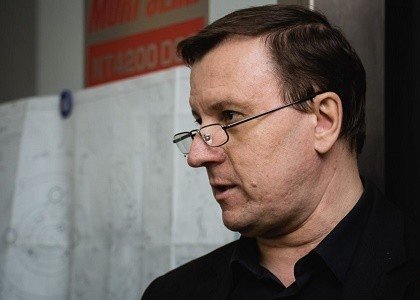In 2018, South Ural State University is going to celebrate its 75th anniversary. In the course of these long years, the university underwent some significant changes, and thousands of talented specialists and brilliant scientists became its alumni. Nowadays the university is represented by entire scientific dynasties among which is the family of Shchurovs.
Igor Shchurov was sent for postgraduate studies to the Chelyabinsk Polytechnic Institute in 1986. After one and a half years of service in the Soviet’s Army, subsequent postgraduate studies and defense of candidate’s dissertation in 1991, Igor Alekseevich became an Associate Professor and Deputy Head of the Department of Machines and Instruments. Having defended Doctor’s dissertation in 1999, he worked as a Professor, and from 2006 till 2012 he was Head of the Department. He has been Deputy Director of the Polytechnic Institute since 2016.
Length of Igor Alekseevich’s academic service at SUSU amounts 30 years, during which he was a witness and participant of many university’s reforms.
One of the episodes of professional experience at the university
“In 2007, in the frameworks of the Education national project, the government allocated a considerable amount of money for modernization of the university’s laboratory facilities. Leadership of the university spent part of these money for buying new computerized machines and establishment of new laboratories. We faced a difficult task to clean the laboratories from old machines using our own efforts and place the new equipment. The Department embraced the task enthusiastically. Engineers, laboratory assistants, teaching staff – everyone joined the work, manually took away the old equipment and helped to renovate the laboratories,” says Igor Alekseevich. “But the supplier named the wrong size of the equipment, so placing it in the prepared laboratories turned out to be impossible. A decision was made to place the machines in the Research and Education Center for Mechanical Engineering. It was uneasy for us to adjust to a new format – the format of creating the centers of collective use. At that time it was difficult, but the Department’s team put away all doubts and the new laboratory had been created.”
.jpg)

Photo: Teaching staff is studying new machines at the Mechanical Engineering REC during classes; Operation using a machine at the Mechanical Engineering REC
Work under new conditions and “training for beginners”
Later, the Mechanical Engineering REC was provided with all the necessary training and industrial equipment: machines for edge cutting and abrasion, for electric erosion machining; coordinate and measurement machines, and analytical equipment. Aside from education process, nowadays there are research and development and technology works carried out at the REC.
“In 2007, we needed to perform training of specialists for working with the new equipment. Just like many other colleagues, I had to undergo an intensive ‘training for beginners’,” says Anna Vladimirovna. “It was necessary to master the training and industrial equipment of the laboratory and use it for training students of both engineering and non-engineering majors. Back then, we managed to complete this task in a very short period of time and implement the equipment to the education process as much as circumstances allowed this. Only after a while everyone realized that establishment of collective centers is a new epoch for our university, the epoch of international cooperation and application of new economic laws and regulations acknowledged in the world’s academic society. The university would need expensive equipment which should operate constantly and efficiently. Therefore on this basis, science as well as research and development should get evolved, articles should get published, and dissertations should be defended.”
Contribution of the family to development of science
.jpg)
Photo: Igor Alekseevich Shchurov , Doctor of Engineering Sciences, Professor; Anna Vladimirovna Shchurova, Candidate of Engineering Sciences, Associate Professor
During the last 5 years, Igor Alekseevich published 5 study guides, 23 research articles, 5 of which are indexed in SCOPUS database and 12 are included in the list of Higher Attestation Commission; 3 certificates for utility model and computer programs were obtained. Under his supervision, 4 students became Candidates of Sciences.
From 2010 till 2016, Igor Alekseevich was a Chairman of the university’s Research Guidance Council in the field of Mechanical Engineering. He is a current member of the university’s Science and Engineering Board, and has been a member of the Board of the Faculty of Mechanics and Technology and of the SUSU Scientific Council for more than 10 years. He performs functions of an expert for a series of scientific and engineering programs, including contests for grants of the Government of the Russian Federation. The scientist has letters of appreciation from the Governor of the Chelyabinsk region, Legislative Assembly of the Chelyabinsk region, First Deputy State Duma Chairman for Industry; a certificate of the Ministry of Education and Science of the Russian Federation. Igor Alekseevich is a honorary worker of the sphere of education in the Russian Federation.
Igor Alekseevich’s wife, Anna Vladimirovna Shchurova is a Candidate of Engineering Sciences, Associate Professor of the SUSU Department of Automated Mechanical Engineering Technology. Having graduated from the CPI in 1984, she started working as an engineer, and later she became a research fellow of the Department of Mechanical Engineering Technology. In 1995 she completed postgraduate studies and defended her Candidate’s dissertation on metal-cutting instruments and metal working.
Anna Vladimirovna teaches the following disciplines: “Fundamentals of quality assurance”, “Metal cutting”, “Technology of engineering materials”, “Technological processes in mechanical engineering’, etc. She published about 55 research works. The length of work of Anna Vladimirovna at South Ural State University is more than 30 years.





